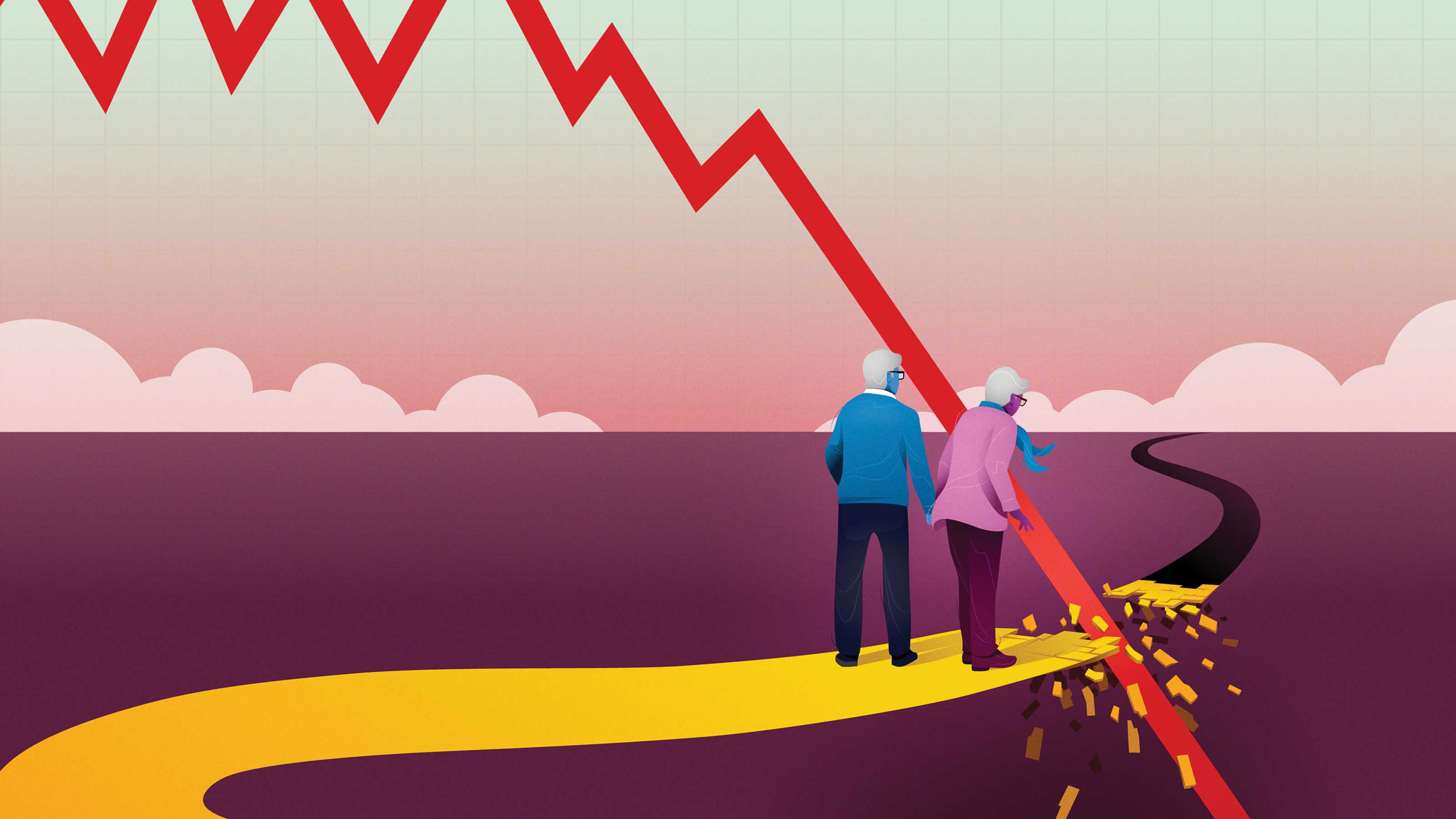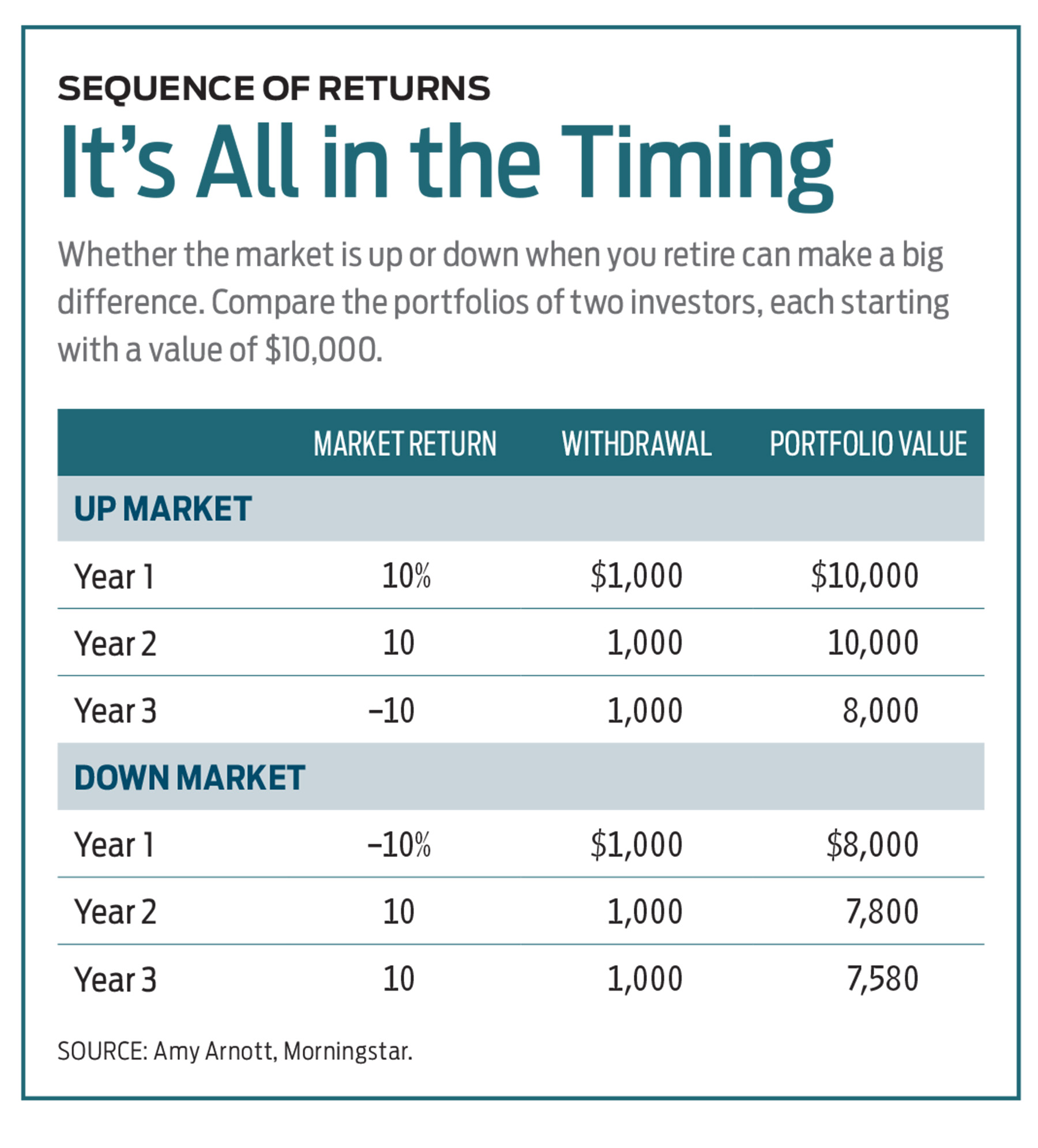Don’t Let a Stock Market Decline Ruin Your Retirement
When portfolio losses hit at the same time as withdrawals, it’s a double whammy. Here’s how to mitigate the risk.


After squirreling away money in a 401(k) or IRA for decades, the last thing you need is a stock market downturn at the start of your golden years. Market sell-offs are always painful, but they pose a greater risk when they occur early in retirement, when you’re no longer earning a paycheck and are withdrawing money from your nest eggs.
A steep decline in the value of your shares just as you’re selling into a falling market is akin to a roadblock set up on the on-ramp to a comfortable retirement. The ill-timed one-two punch of lousy performance and cash outflows can put a dent in your retirement savings, and it can be hard for your portfolio to recover. “Those early years are really important. It’s just the way the math works,” says Rob Williams, managing director of financial planning and retirement income for the Schwab Center for Financial Research.
Wall Street refers to this investment peril as sequence-of-returns risk. The risk is that annual portfolio losses are front-loaded near the start of retirement, when you begin to withdraw funds, severely weakening your portfolio’s growth potential and its ability to provide steady income over decades despite an eventual market recovery. The sequence of returns “can make a difference between having enough money to last throughout your life span or running out of money or cutting back on the lifestyle you planned for,” says Amy Arnott, a portfolio strategist at Morningstar. Taking the same withdrawals early in retirement during an up market allows you to maintain your account value over the long term while paying yourself along the way.

Sign up for Kiplinger’s Free E-Newsletters
Profit and prosper with the best of expert advice on investing, taxes, retirement, personal finance and more - straight to your e-mail.
Profit and prosper with the best of expert advice - straight to your e-mail.
A Crack in the Nest Egg
Consider a hypothetical example from Schwab that looks at the impact of either three poor early years or three poor late years on a $1 million portfolio over a 20-year span. The analysis assumes that an investor withdraws $50,000, or 5% of the portfolio, at the beginning of the first year of retirement, then in years two through 20 takes out the same amount plus an increased withdrawal to account for a 2.5% annual inflation rate. The unlucky poor-early-years investor who suffers losses of 15% in each of the first three calendar years after retirement and then earns 10% annual returns every year thereafter would run out of money in year 18. But the poor-late-years investor who earns 10% annual returns for the first 17 years and suffers losses of 15% in years 18, 19 and 20 would have a balance totaling $1.34 million in year 20.
What accounts for the sharp disparity in outcomes? The combination of poor returns and taking distributions in the early years of retirement—what Wall Street pros call the red zone—can deplete an account balance prematurely. “Portfolio withdrawals compound losses,” an analysis by money management firm BlackRock found.
Taking distributions from stock holdings in a down market hurts in two ways. First, you’ll have to sell more shares to generate the income you need than you would if stock prices were higher. Second, after selling you have fewer shares left over that can benefit from the next favorable market. “You’re missing out on the rebound,” Arnott says. Multiyear stock market declines that occur in your seventies and eighties after years of positive gains, she notes, are less damaging. Why? Your portfolio has already benefited from years of growth via the compounding of returns. Plus, you have fewer years of retirement left, which lowers your odds of running out of money.
The good news? It’s rare for the U.S. stock market to suffer multiple down years in a row. There have been only four periods over the past 93 years (1929–32, 1939–41, 1973–74 and 2000–02) when the broad market tumbled for at least two straight calendar years, according to Morningstar. The bad news? “When it does happen,” says Arnott, “it can cause you significant financial pain and damage.”
Mitigate the Risk
One way to make sure a crack in your nest egg doesn’t completely break your portfolio is to avoid going into retirement holding 100% of your investments in stocks, Arnott says. For example, a new retiree with a $1 million all-stock portfolio at the end of 1999, taking $40,000 annual withdrawals (with increases of 2% for inflation in subsequent years), would have seen the account lose nearly half of its value in the 2000–02 bear market, according to Arnott. And selling shares during the multiyear downturn would have made it harder to take advantage of the market’s 28.4% gain in 2003.
To cushion a potential hit from sequence-of-returns risk, make sure you have a healthy stake in lower-volatility fixed-income assets, such as bonds and cash, which provide more stability to your portfolio. Not only will your portfolio suffer less volatility and smaller losses, you’ll also be able to access cash without having to sell stocks when prices are depressed. It’s also a good idea, Arnott says, to set aside a bucket of cash equal to one or two years’ worth of living expenses so you can ride out a lengthy market storm without having to sell shares.
Just don’t get too conservative. That’s because you can dampen sequence-of-returns risk simply by building a larger nest egg in the run-up to retirement, according to mutual fund company T. Rowe Price. The argument is that a more growth-oriented, stock-heavy strategy would generate bigger account balances than more-conservative portfolios, leaving investors with more money even after market declines near or early in retirement. For example, a newly retired investor with a $900,000 portfolio who suffers a 5% loss will see the balance fall $45,000, to $855,000. Another retiree with $1 million who lost 10% would still be left with $900,000. “There is a trade-off to a more conservative glide path,” says Kim DeDominicis, a port-folio manager for T. Rowe’s target-date funds.
Unlucky investors on the wrong side of a market return sequence can protect their portfolios by reducing the size of their retirement account distributions, especially from stock holdings. If you originally planned to withdraw 4% of your portfolio each year, dial that back to 3% or 2% in down market years. You can also opt not to boost your withdrawal amount to account for inflation. Worst case, you could skip withdrawals altogether. “Do what you can to reduce the downward pressure on your portfolio,” says Schwab’s Williams. “Don’t give yourself a pay increase.” If necessary, he adds, slash expenditures for stuff you don’t need

Get Kiplinger Today newsletter — free
Profit and prosper with the best of Kiplinger's advice on investing, taxes, retirement, personal finance and much more. Delivered daily. Enter your email in the box and click Sign Me Up.

Adam Shell is a veteran financial journalist who covers retirement, personal finance, financial markets, and Wall Street. He has written for USA Today, Investor's Business Daily and other publications.
-
 Should You Do A Roth IRA Conversion? Nine Things to Consider
Should You Do A Roth IRA Conversion? Nine Things to ConsiderThe Tax Letter Thinking of converting a traditional IRA to a Roth IRA? The Kiplinger Tax Letter Editor highlights nine factors you should consider before making a move.
By Joy Taylor
-
 33 Stocks That Could Rally 50% or More This Year
33 Stocks That Could Rally 50% or More This YearAnalysts say these S&P 500 stocks have at least 50% price upside over the next year or so.
By Dan Burrows
-
 457 Plan Contribution Limits for 2025
457 Plan Contribution Limits for 2025Retirement plans There are higher 457 plan contribution limits for state and local government workers in 2025. That's good news for state and local government employees.
By Kathryn Pomroy
-
 Medicare Basics: 11 Things You Need to Know
Medicare Basics: 11 Things You Need to KnowMedicare There's Medicare Part A, Part B, Part D, Medigap plans, Medicare Advantage plans and so on. We sort out the confusion about signing up for Medicare — and much more.
By Catherine Siskos
-
 The Seven Worst Assets to Leave Your Kids or Grandkids
The Seven Worst Assets to Leave Your Kids or Grandkidsinheritance Leaving these assets to your loved ones may be more trouble than it’s worth. Here's how to avoid adding to their grief after you're gone.
By David Rodeck
-
 SEP IRA Contribution Limits for 2025
SEP IRA Contribution Limits for 2025SEP IRA A good option for small business owners, SEP IRAs allow individual annual contributions of as much as $70,000 in 2025, up from $69,000 in 2024.
By Jackie Stewart
-
 Roth IRA Contribution Limits for 2025
Roth IRA Contribution Limits for 2025Roth IRAs Roth IRA contribution limits have gone up. Here's what you need to know.
By Jackie Stewart
-
 SIMPLE IRA Contribution Limits for 2025
SIMPLE IRA Contribution Limits for 2025simple IRA The SIMPLE IRA contribution limit increased by $500 for 2025. Workers at small businesses can contribute up to $16,500 or $20,000 if 50 or over and $21,750 if 60-63.
By Jackie Stewart
-
 457 Contribution Limits for 2024
457 Contribution Limits for 2024retirement plans State and local government workers can contribute more to their 457 plans in 2024 than in 2023.
By Jackie Stewart
-
 Roth 401(k) Contribution Limits for 2025
Roth 401(k) Contribution Limits for 2025retirement plans The Roth 401(k) contribution limit for 2025 increased, and workers who are 50 and older can save even more.
By Jackie Stewart